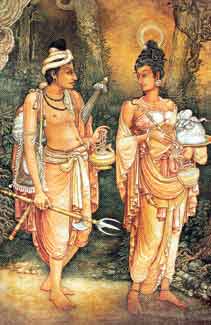Sri Dalada – the Sacred Tooth Relic of the Buddha – is the most precious object of worship for Buddhists the world over. Devotees flock to the Sri Dalada Maligawa in Kandy every day to pay homage to the Relic. Housed in several golden caskets in the inner chamber of the Maligawa, the Relic is protected with great veneration with offerings being made throughout the day at specified times by monks of the Malwatta and Asgiriya Chapters of the Siyam Nikaya nominated for the purpose.
 |
| Renowned artist Solias Mendis’ painting of Princess Hemamala and Prince Danta bringing the Sacred Tooth Relic from India to Sri Lanka |
The traditional customs in paying homage to the Tooth Relic date back to the days of King Kitsiri Mevan (303-331 CE) who was ruling in Anuradhapura at the time the Relic was brought from Dantapura in Kalinga (India) by Princess Hemamala disguised as a Brahmin lady. It was the ninth year of his reign. The princess who came along with Prince Danta found her way to the Meghagiri Vihara, a temple near Anuradhapura. The monks received the Relic with veneration until the King hearing the news came and took it into his care. The Relic was brought to the palace and kept in a shrine within the palace and it is recorded that the King dedicated the entire island to the Sri Dalada. He later ordered that the Relic be taken in procession to the Abhayagiri Vihara and exhibited to the people.
Successive kings venerated and protected the Relic as it was soon accepted as the symbol of royalty. The Cola invasion in 947 CE saw the destruction of Buddhist places of worship including the Temple of the Tooth. King Mahinda IV (956-972), a great benefactor of Buddhism, restored the edifice which had been burnt down.
Civil war in Polonannaruwa after the capital was shifted there and the indifference shown by the rulers towards the Sangha, made the monks take away the Tooth and Bowl Relics secretly. They were hidden in Ruhuna. When Parakramabahu I (1153-1186) took over Polonnaruwa, the Relics were in the possession of Queen Sugala, the ruler in Ruhuna. While Parakramabahu was keen to get back the Relics because his right to sovereignty remained imperfect and challengeable without them, Queen Sugala took them and sought refuge elsewhere. However, he succeeded in obtaining the Relics and when they were brought to Polonanaruwa he arranged for a great festival of rejoicing and adoration of the Relics which were exhibited in a specially constructed 'mandapaya' for the people to worship. They were then deposited in the Temple of the Tooth.
Professor Senerat Paranavitana states that the belief that the possession of the Tooth Relic conferred on a prince the legitimate right to sovereignty appears to have become established during the Polonnaruwa period. He believes the principal objective of Parakramabahu's war in Ruhuna was to secure the Tooth and Bowl Relics. "Even to this day the belief is current that rain will fall when the Tooth Relic is taken out in procession: the belief explains the importance which its possession lent to the king, one of whose functions, according to the ideas of people in ancient days, was to ensure the fall of rain in due season. Vijayabahu, a courtier of Parakramabahu, and Nissankamalla built costly edifices for the Relic on the Tooth Relic Terrance at Polonanruva," he writes in 'History of Ceylon'.
It is stated that the Tooth Relic festival was one of 64 Buddhist festivals solemnised every year by Parakramabahu.
Mention is made that with trouble brewing in Polonnaruwa in later years, the Tooth and Bowl Relics were concealed in Kotmale. In the Dambadeniya period, during the reign of Vijayabahu III (1232-1236), they were brought and kept in a temple built at Beligala. The Tooth Relic had been shifted to Yapahuva, Gampola and Kotte as the capitals changed until it had to be protected from the Portuguese invaders who showed no sympathy towards Buddhism. The Relic is said to have been hidden in a 'kurakkan gala' – a stone crusher used to pound 'kurakkan' – in the Delgamu Vihara in Sabaragamuwa for many years.
The shifting of the Tooth Relic to Kandy was during the reign of King Vimaladharmasuriya I (1591-1604) who handed over custody to the Maha Nayaka Theras of the Malwatta and Asgiriya Chapters. The Relic has remained in the Dalada Maligawa built by him although it has been shifted temporarily whenever there were threats of invasion by foreign powers.
The exposition
The 11-day exposition of the Sacred Tooth Relic begins on Friday, March 6 and will continue from 1 - 5.30 p.m. daily.
Authorities have planned eight queues for the convenience of the clergy and lay devotees. One will be exclusively for Ranaviru families and another for the Police and their families. Forty mobile toilets are being set up in addition to other facilities for pilgrims. Plans are also being made to provide accommodation and meals for those who are unable to view the Tooth Relic due to the closure of queues. |

